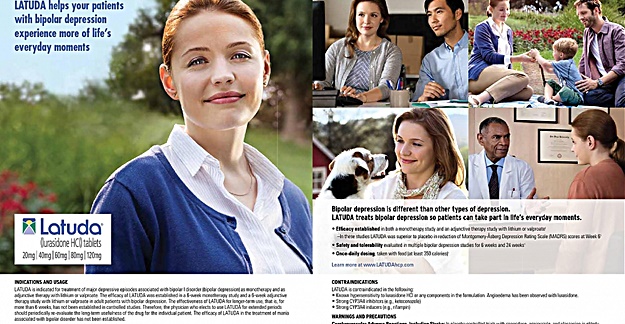Are consumers inundated with risks and side effects in drug ads to the point they don’t pay attention to that important information?
It seems that you can’t open a popular magazine these days without coming across at least one drug ad. Direct-to-consumer (DTC) print ads are a key method the pharmaceutical industry uses to boost prescriptions by encouraging patients to discuss a particular medication with their physician.
These ads normally tout the benefits of the drug in large fonts, while the risks are presented in much smaller type, aka the fine print. I doubt many people who see those ads actually read through the risks.
Even though a drug’s benefits are much more prominently shown in a DTC ad, drug companies have argued that the amount of risk information presented in the ads is too much. FDA regulations require that risk information in an ad needs to be placed in the important safety information (ISI) section, which is usually found in the main part of the ad, as well as in the brief summary section, which is usually on a second page and is actually not very short at all. This is the fine print I referred to.
The FDA appears to be listening. This month, the agency said it was accepting comments on a planned research project, the Experimental Study on Risk Information Amount and Location in Direct-to-Consumer Print Ads. The notice says the study will “examine how repetition and overwarning apply to the presentation of risks in the context of direct-to-consumer print advertising.”
The study itself would involve 2 versions of a fake drug ad. One would state the risks in the ISI section as it is now. The other would feature an abbreviated version of those risks. Researchers will then use eye tracking technology to measure where in an ad and for how long a person is reading. The FDA says that eye movement patterns can indicate attention to and understanding of the risks.
The agency contends overwarning may be dangerous because if a consumer sees too many warnings during their day, they are less likely to pay attention to any particular one. “Detailing too many risks may lead consumers to discount all risks, or miss the most important risk information.”
In addition, they warn of “habituation,” which happens when consumers see the same warnings over and over again and stop paying attention to them.
The issue is not that patients are getting too much or not enough information about a drug’s risks in ads, but the way the risk information is presented.
The concern about overwarning seem to be overblown. Why? An FDA survey published in 2004 found that 60% of consumer respondents felt that the ads didn’t provide enough information about risks. The same survey also included physicians. It found that a majority of them thought patients confused the risks and benefits of drugs in ads, and that the ads lead patients to overestimate the efficacy of the medications.
“Patients gave only modest ratings to the understandability of the brief summary included in print advertisements, information that is meant to provide a more complete picture of the advertised product’s risks,” the report concluded.
It seems to me that the issue is not that the patients are getting too much or not enough information about a drug’s risks in ads. The problem is that the way risk information is presented is poor.
There are several steps that could be taken. One would be to simplify the language used in the risks section of ads so that it is less technical. This would help people with limited reading proficiency to better understand the risks. A prior study suggested that such language be presented at no higher than the 8th grade level.
Joel Davis, PhD, of San Diego State University, came up with several ideas to improve the way risks are presented in ads based on a survey conducted with consumers. He suggests that when key side effects are presented in a bullet-point format, they be listed in order from most common to least. He would also include numerical data, such as the percentage of patients that experienced each side effect. He also suggests they include placebo group information on side effects for comparison. Inclusion of drug discontinuation data would also help patients weigh the risks and benefits of a drug, he notes.
Rather than worry about overwarning or repetition of risks in drug ads, the FDA would be better off examining better ways of presenting risk information to consumers in the first place. And any efforts to lower the amount of risk information presented to consumers would benefit a drug company while taking away the “fair balance” of benefits and risks in an ad that the FDA says is necessary.






